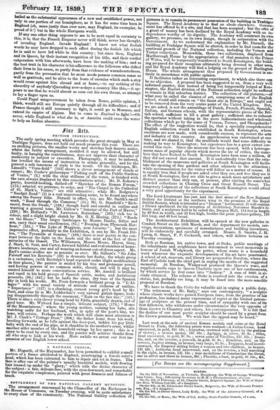SETTLEMENT OF THE NATIONAL GALLERY QUESTION.
The arrangement announced by the Chancellor of the Exchequer in the House of Commons, on Tuesday, evening, will be quite satisfactory to every class of the community. The National Gallery collection of
pictures is to remain in permanent possession of the building in Trafalgar Square. The Royal Academy is to find an abode elsewhere. Govern- ment has offered to it a site, and that has been accepted ; but the offer of a grant of money has been declined by the Royal Academy with an in- dependence worthy of its dignity. The Academy will construct its own gallery, we presume, on its own design, though in coOperation with the Government. As we understand the explanation by Mr. Disraeli, the building at Trafalgar Square will be altered, in order to find room for the continual growth of the National collection, including the Vernon and Turner collections. Meanwhile, those two collections, displaced from Marlborough House by the appropriation of that mansion to the Prince of Wales will be temporarily transferred to South Kensington, the build- ing prepared for their reception ultimately being devoted to other uses, and the Royal Academy will find a lodging on the ground of Burlington House. The whole arrangement thus proposed by Government is en- tirely in accordance with public opinion.
It facilitates rather an interesting experiment, to which also there can be no objection. A proposal has been suggested to us from a very well informed quarter, that instead of being but temporarily lodged at Ken- sington, the English division of the National collection might be suffered to remain in that suburban district. The collection of old pictures,—of what may be called the classics of art, comprising some of the English school, would still remain on "the finest site in Europe," and ought not to be removed from the very centre point of the United Kingdom. But, we are asked, is not the assemblage of Dutch, French, Flemish, Spanish, Italian, and German schools, with the representative pieces of the Bri- tish school, sufficient to fill a great gallery ; sufficient also to exhaust the spectator without taking in the more indiscriminate and wholesale collections which go by the name of Vernon, Turner, and Sheepshanks ? The effect of the suggestion would be, that a specially comprehensive English collection would be established in South Kensington, where exertions are now made, with considerable success, to represent the arts and industry of this country. An apprehension was entertained at one time, and we shared it, that the multitude would find some difficulty in making its way to Kensington ; but experience has to a great extent cor- rected this view. Since the museum has been opened, with a heteroge- neous mass of popular objects which moves the ire of critics, the num- bers that have flocked to South Kensington have been near a million, if they did not exceed that amount. It is undoubtedly true that the este- blislment of the museums and galleries at South Kensington will facili- tate the opening of fine gardens and other adjuncts to the attraction; while accommodation for the visitor will follow as a matter of course. It is equally true that if people are asked what they see, and how they see it at South Kensington they are able to give a much more satisfactory and distinct answer than they can, at present, after visiting the somewhat crowded collections in Charing Cross and Great Russell Street. The temporary lodgment of the collections at South Kensington would afford a very good opportunity for the experiment.


































 Previous page
Previous page